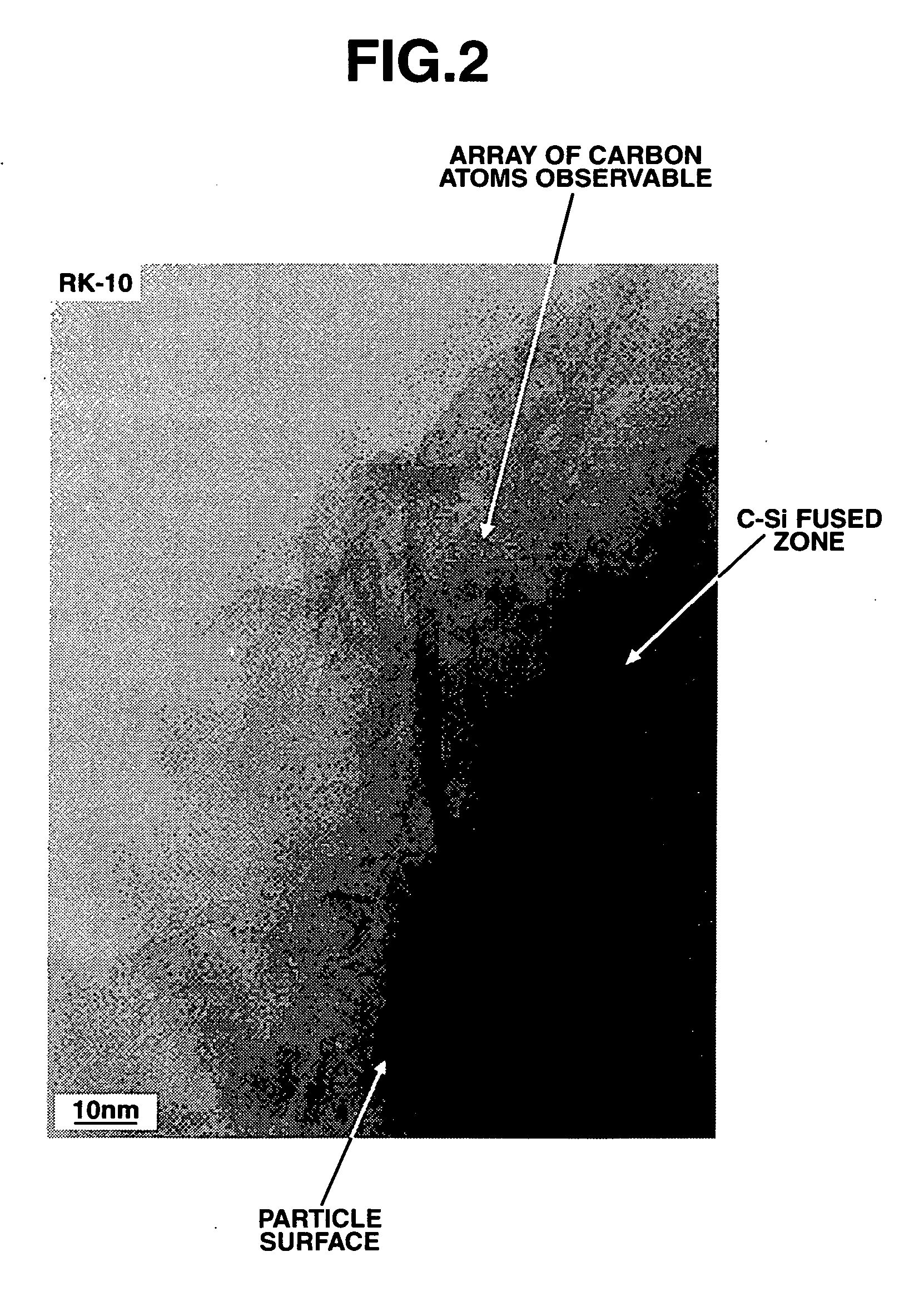Non-aqueous electrolyte secondary cell negative electrode material and metallic silicon power therefor
a secondary cell, non-aqueous electrolyte technology, applied in the direction of cell components, silicon compounds, cellulosic plastic layered products, etc., can solve the problems of varying cycle performance, silicon samples showing varying degradation by repeated charge/discharge cycles, and most silicon oxides have not reached the practical level, etc., to achieve the effect of improving cycle performan
- Summary
- Abstract
- Description
- Claims
- Application Information
AI Technical Summary
Benefits of technology
Problems solved by technology
Method used
Image
Examples
example 1
[0054] Metallic silicon of the chemical grade (low aluminum grade by SIMCOA Operations PTY. Ltd., Australia; Al 0.04%, Fe 0.21%, Ca 0.001%, Ti 0.005%, and O<0.01%) which had been purified by blowing oxygen into the melt at the stage immediately after taking out in a ladle so that the contents of Al and Ca were reduced from 0.23% and 0.07% to the above-identified values, respectively, was crushed on a jaw crusher, and milled on a ball mill and a bead mill using hexane as the dispersing medium, into fine particles having an average particle size of about 4.0 μm. The resulting suspension was filtered and dried (solvent removal) in a nitrogen atmosphere. A coarse particle fraction was cut off using a pneumatic precision classifier (Nisshin Engineering Co., Ltd.), obtaining a powder having an average particle size of about 3.5 μm. The silicon fine powder was subjected to thermal CVD in a methane-argon stream at 1,200° C. for 5 hours, obtaining a carbon-surface-coated silicon powder havin...
example 2
[0061] Purified metallic silicon of the chemical grade (low aluminum grade by SIMCOA; Al 0.04%, Fe 0.21%, Ca 0.001%, Ti 0.005%, and O<0.01%) used in Example 1 was crushed on a jaw crusher, and milled on a ball mill and a bead mill using hexane as the dispersing medium, into fine particles having an average particle size of about 1 μm. The resulting suspension was filtered and dried in a nitrogen atmosphere. The product containing agglomerates of particles was disintegrated on an automated mortar, obtaining a metallic silicon powder having an average particle size of 1.3 μm.
example 3
[0062] In the process of preparing metallic silicon of the chemical grade, metallic silicon (low aluminum grade by SIMCOA; Al 0.23%, Fe 0.25%, Ca 0.07%, Ti 0.01%, and O<0.01%) was not purified by blowing oxygen into the melt so as to reduce the contents of Al and Ca. As in Example 1, the metallic silicon was crushed on a jaw crusher, and milled on a ball mill into particles having an average particle size of 85 μm. Then 200 ml of 0.5% hydrofluoric acid was added to 100 g of the silicon powder for washing away impurities, followed by thorough rinsing. After drying, the particles were milled on a bead mill using hexane as a dispersing medium, into fine particles having an average particle size of about 1.2 μm. The resulting suspension was filtered and dried in a nitrogen atmosphere. The product was similarly disintegrated on an automated mortar, obtaining a metallic silicon powder having an average particle size of 1.3 μm (Al 0.005%, Fe 0.002%, Ca<0.001%, Ti 0.003%, and O<0.01%).
PUM
| Property | Measurement | Unit |
|---|---|---|
| Fraction | aaaaa | aaaaa |
| Fraction | aaaaa | aaaaa |
| Fraction | aaaaa | aaaaa |
Abstract
Description
Claims
Application Information
 Login to View More
Login to View More - R&D
- Intellectual Property
- Life Sciences
- Materials
- Tech Scout
- Unparalleled Data Quality
- Higher Quality Content
- 60% Fewer Hallucinations
Browse by: Latest US Patents, China's latest patents, Technical Efficacy Thesaurus, Application Domain, Technology Topic, Popular Technical Reports.
© 2025 PatSnap. All rights reserved.Legal|Privacy policy|Modern Slavery Act Transparency Statement|Sitemap|About US| Contact US: help@patsnap.com



